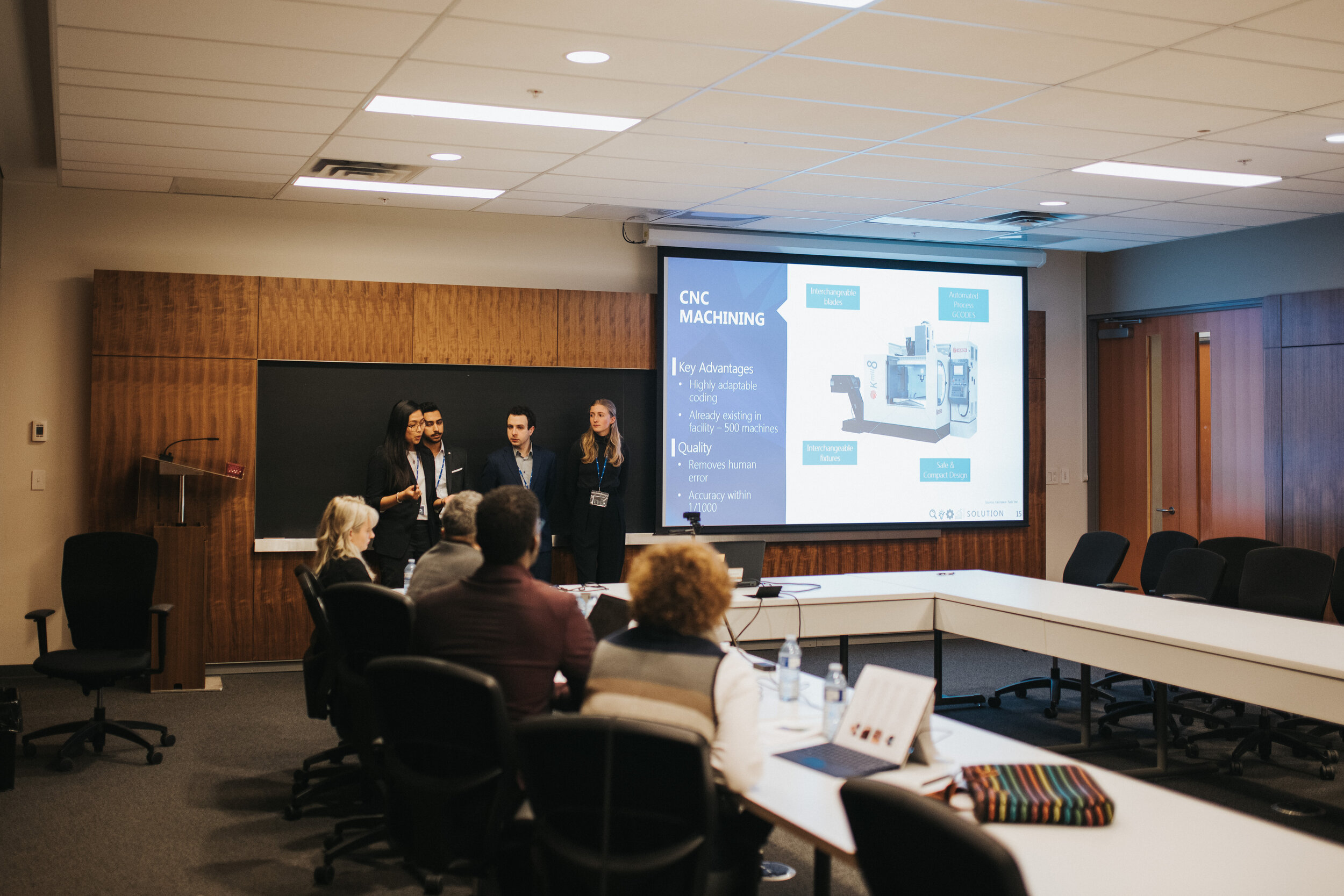1.BUILDING AN ENGCOMM LEVEL TEAM
Preparing for ENGCOMM is an exciting journey that starts with forming your team. To thrive in our competition, where engineering and business converge, we recommend a balanced team composition: two engineering students and two business students. This blend of expertise positions your team well for the complex challenges ahead. Imagine enhancing a product’s quality and efficiency while cutting costs and production time, or revolutionizing a local business's delivery system to expand its market reach. In these scenarios, having diverse knowledge and perspectives is your key to success. So choose wisely and gear up for an enriching experience at ENGCOMM!
HOW TO BUILD A DIVERSE TEAM
1. Explore Your Connections
Tap into your circle. Know engineers or business students eager for a challenge? Reach out!
2. Leverage Social Media
Join your university's business/engineering groups. Find peers with shared passion and drive – they could be the perfect fit for your team.
2. COMPETITION PREPARATION GUIDELINES
HOW TO PREPARE BEFORE THE COMPETITION
Preparing for ENGCOMM goes beyond understanding cases; it's about building your strategic and analytical prowess. We suggest immersing yourself in diverse case studies to gain insight into various industries. Start honing your skills early, tapping into the breadth of knowledge across business and engineering disciplines to sharpen your competitive edge. Success in the competition comes from early and rigorous preparation, ensuring you and your team are ready to tackle the complexities that ENGCOMM cases present.
WHAT SHOULD I DO PRIOR TO THE CASE COMPETITION
Meet your teammates: Begin by getting to know your teammates' abilities. Early collaboration allows you to strategize using each member's strengths and identify areas for improvement. Establish clear communication channels to foster teamwork.
Meet your coach: Your coach is a valuable resource for learning and development. They bring a wealth of experience and can provide critical feedback and best practices. Regular meetings with your coach can help refine your approach and enhance your performance.
Watch Past Case Presentations: Analyze past case presentations to understand successful strategies and common pitfalls. Take note of effective presentation styles and arguments that resonated well with judges.
Practice: Tackle mock cases to become familiar with different problem types and learn the nuances of case phrasing and structure. Frequent practice helps in developing a keen eye for critical details and underlying issues.
Create a Practice Schedule: Consistency is key. Set up a practice schedule that all team members can adhere to. Regular practice sessions in a simulated competition environment will build your team's confidence and ability to perform under pressure.
3. CASE ANALYSIS GUIDELINES
UNDERSTANDING AND ANALYZING THE PRESENTED CASE
Regardless of your team’s intellectual capacities, case competition performance is strongly driven by your team’s understanding of the issue that is presented. Taking the necessary time to interpret and develop a well-rounded approach to the problem at hand will be among the most important steps of your preparation period. To ensure you make the most out of the time that is allocated to you, here are a few pieces of advice you should consider prior to entering the preparation room.
1. Read. Carefully.
Allocate the first 30 minutes for a thorough examination of the case. Encourage each team member to annotate and highlight pivotal data. This isn't just about understanding the case's narrative but about identifying strategic information, assumptions made, and data points crucial for later analysis. Starting with the introductory and concluding sections gives an overarching view, allowing you to prioritize information effectively as you progress through the details.
2. In-Depth Discussion.
With notes in hand, convene a focused discussion where each member shares their insights. Assign a scribe to document these perspectives. This step is not merely about reaching a consensus but about leveraging each person's unique take to enrich your collective interpretation, ensuring a multifaceted approach to the case.
3. Problem Framing
Now, synthesize your collective intelligence to crystallize the core issue. This isn't just about narrowing down to a problem statement but about understanding its nuances, how it affects different stakeholders and its implications. A well-defined problem will act as a beacon, guiding your solution development.
4. Methodical Solution Mapping
After establishing your solution, meticulously categorize the information at your disposal. This involves separating what you know from what you need to investigate further. This clear delineation will direct subsequent research and analysis, ensuring you remain on track and focused on filling in the gaps in your case strategy.
By intensifying the detail in each of these steps, your team will be equipped to construct a well-informed and comprehensive response to the case, grounded in both theoretical knowledge and practical application.
4. DIVIDING THE WORK
When dividing tasks for a case competition, a tailored approach that capitalizes on each delegate's expertise is essential. Given ENGCOMM’s balanced scoring between engineering and business solutions, it's crucial to match tasks to the corresponding skill set. Engineering students might take on roles that demand a deep understanding of the technical aspects, such as optimizing product design for efficiency, evaluating materials for cost and performance, or integrating sustainable practices to minimize environmental impact.
Business students, on the other hand, could be responsible for dissecting market trends to inform strategic decisions, crafting a compelling marketing strategy that resonates with the target audience, or constructing detailed financial models to ensure the solution's economic viability.
To foster a seamless and effective presentation, it is advisable for team members to research, develop, and present their own segments. This approach not only enhances the presentation flow but also ensures each presenter is thoroughly versed in their topic, leading to a more confident and persuasive delivery.
Additionally, distributing the remaining elements of the presentation, such as the introduction, problem statement, implementation plan, and conclusion, can help balance the workload. This not only ensures an equitable distribution of tasks but also enables each team member to contribute to the narrative arc of the presentation, creating a cohesive and unified final product.
Regular checkpoints to integrate and synchronize the team's work will ensure cohesion and that all parts align to form a comprehensive response to the case. This detailed division of labor positions a team to perform efficiently under the time constraints of the competition.
Bonus Tips:
Ensure every part of your case solution is backed by solid data or well-articulated assumptions. Understanding each other's contributions is crucial for a united front during presentations and Q&A sessions.
Communication is key: Regularly update your team on your progress. Consider setting scheduled check-ins to synchronize efforts and maintain momentum.
Utilize your coach's expertise for strategies on task division and insights that can fine-tune your team's approach. Their guidance is instrumental in enhancing your team's performance.
5. VISUAL SUPPORT
CRAFTING IMPACTFUL VISUAL AIDS
Transform your presentations from good to great with powerful visuals. Capture your audience's attention and communicate more effectively by integrating meaningful and high-quality images, animations, and diagrams that complement your narrative.
Streamline Your Visual Storytelling
Outline Your Story: Begin with a clear objective and a simple, impactful narrative. Choose a cohesive color palette and imagery that aligns with your topic.
Clarity is Key: Use visuals to underscore your main points, allowing the audience to listen actively without reading dense text.
One Message Per Slide: Focus each slide on a single message supported by one striking visual to drive the point home.
Simplify: Avoid clutter and excessive effects. Limit the number of slides to maintain engagement.
Engage, Don’t Read: Give your audience time to absorb each slide. Speak to them, not at the screen.
Remember, your delivery—how you look, stand, and express yourself—is as crucial as your slides. Rehearse thoroughly to ensure a compelling presentation.
Enhance with Design Elements:
Subtle Animation: Employ minimal animation to guide focus—our eyes are naturally drawn to movement.
Personalize with Images: Select photos and illustrations that resonate with your message, making your presentation relatable and memorable.
Visualize Data: Use graphs and charts for statistical data and organizational maps to clarify complex information.
Show, Don’t Tell: Demonstrate processes with GIFs or illustrations to make abstract concepts tangible.
With these guidelines, you’ll be well on your way to creating a presentation that not only informs but also inspires.
6. PRESENTATION SKILLS
HONING YOUR PUBLIC SPEAKING
Mastering public speaking is a journey towards conveying your ideas with clarity and enthusiasm. Great speakers radiate confidence and connect with their audience on both an intellectual and emotional level.
Key Attributes of Successful Speakers
Confidence and Passion: Embrace your topic with genuine interest and excitement. Be authentic in your delivery to forge a real connection with your audience.
Conciseness and Engagement: Deliver your messages succinctly. Engage your listeners with a narrative that is both compelling and brief.
Storytelling: Paint vivid pictures with your words to create memorable and persuasive arguments.
Exercises to Elevate Your Speaking
Master Your Message: Focus on the essence of your slides. Summarize key concepts, stories, and takeaways rather than memorizing every line.
Sensory Speech: Augment your spoken words with visual and auditory elements to create a rich, multi-sensory experience.
Audience Interaction: Seek ways to involve your listeners, transforming a monologue into a dialogue.
Audience First: Shift the spotlight to your audience's needs and interests. Your performance should be about their experience, not your own.
By prioritizing these elements, you're not just speaking to the audience; you're resonating with them.
The Power of Narrative
Storytelling isn't just a technique; it's an art that bridges the gap between data and emotion. Share personal anecdotes or narratives that resonate with your audience's values and beliefs. Weave in relevant facts to challenge and stimulate the analytical mind. Remember, a story well told is a journey well shared.
7. ANTICIPATING QUESTIONS
MASTERING THE ART OF Q&A
Navigating the Q&A session is an art that can elevate your presentation from informative to outstanding. It's where you can showcase your depth of knowledge and quick thinking. Here’s how you can sharpen your Q&A skills:
Strategic Preparation:
Empathy in Anticipation: Step into the minds of your audience and judges—what would you ask? Brainstorm potential questions and prepare your responses.
Confidence is Key: Address each question with assuredness. Your response reflects your command over the subject.
Fact-Filled Answers: Strengthen your replies with facts. A well-placed statistic or data point can make your answer stand out, even if it diverges slightly from the query.
Engagement Tactics:
Prompt the Dialogue: Design your presentation to invite questions. Strategically leaving 'thought gaps' can spark curiosity and lead to a more dynamic Q&A session.
Back-Up Strategies: Always have a contingency plan for unexpected questions. Avoid guessing—instead, offer to provide a detailed answer post-presentation if necessary.
Remember, questions are not hurdles; they're springboards for you to demonstrate expertise and enthusiasm. Welcome them as chances to impress and engage.





























